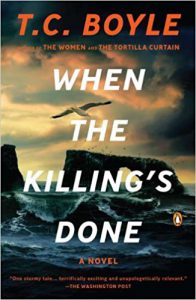When the Killing’s Done, by T.C. Boyle
When the Killing’s Done
T.C. Boyle
Viking
Three stars
Reviewed by Jessica Gribble
T.C. Boyle is a dynamic writer with an expansive vocabulary. He’s won several book awards, including the PEN/Faulkner Award; he’s been a National Book Award finalist; and his books frequently appear on the New York Times bestseller list. Boyle chooses controversial topics and then weaves chatty novels around them; his characters are modern and the language in the books feels instantly familiar. His current book is no exception: the topic is how humans interact with the environment, and while the scenarios feel a bit stale, they do represent both sides of this divisive issue.
When the Killing’s Done is mostly set in the Northern Channel Islands, where Alma Boyd Takesue’s grandmother survived a boat wreck and where Alma will fight most of the environmental battles that drive the storyline. Alma is projects coordinator and director of information resources for the National Park Service, Channel Islands. It’s her job to make sure the islands are returned to their original environment, which means eradicating black rats and wild pigs. (The astute reader will notice the rats that Alma’s grandmother encountered when she clambered her way onto Anacapa Island after the shipwreck.) Of course, Alma’s nemesis, Dave LaJoy, intends to save the animals that the park service wants to remove. And there you have your controversial issue. Alma is environmentally conscious in her regular life and Dave is rich. Neither one completely fits his or her stereotype: just like in real life! Each main character’s retinue of friends and loved ones contributes to the battle for the islands: Alma’s partner Tim and her mother, Dave’s folk-rock girlfriend Anise and buddy Wilson. The climax of the novel includes another dialectic: the intrusion of new life and the shattering of death.
Two extended scenes in the book are expertly paced. The first is the wreck of the Beverly B with Alma’s pregnant grandmother aboard. I actually felt buffeted by the waves and plunged into the sea. I stopped paying attention to the language and just went for a ride—sunburn, thirst, and the terror of dying making way for relief when Beverly is finally safe (if alone) on the island. The second excellent scene features Anise’s mom, Rita, as the cook for a sheep ranch on Santa Cruz Island, learning how to cook lamb, mutton, and sheep stew for seven sheepherders. When a gunshot spooks the mother sheep away from their babies, the carnage that follows is heartbreaking, and the characters’ anguish is perfectly rendered.
But these two great scenes don’t save the book. First, the book’s aesthetics detract from the reading experience. It suffers from a strange mixture of fonts, from a swoopy one reminiscent of pirates, to a main title so plain you barely notice it, to an old-horror-movie-poster font used on the front cover and spine. The lurid colors in the cover art are unnecessarily gothic. Also, the characters aren’t likeable, which makes it hard to care about what happens to them. Their flaws are totally realistic, but their overall personalities are caricatures: the hippie environmentalist with dreadlocks, the earnest Asian American do-gooder. And the plot is as sensationalized as the cover image. I couldn’t believe the abrupt ending, which had unfortunate similarities to “and then they woke up!” It even includes an element that feels like a teaser for a movie sequel. I don’t think this is T.C. Boyle’s best work, but it does follow his very interesting premise of highlighting controversial issues and balancing both sides so that one doesn’t easily win out. If you like that sort of plot, fast-paced action, and entertaining dialogue sequences, you’ll enjoy this book.
